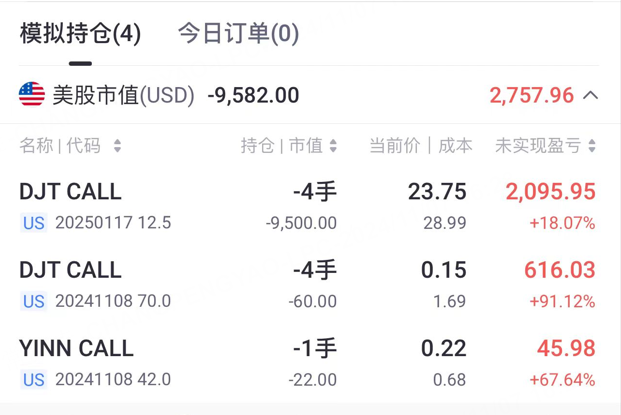【🎁有獎話題】以做空DJT爲例,賣出看漲期權新手攻略
一、建立對賣出看漲期權的基本理解
沒有接觸過期權的朋友,可能對賣出期權很難理解,經常會有“我沒有期權怎麼賣?”、“賣期權到底有什麼意義”等疑惑,這裏我們可以通過一個現實生活裏賣二手車的案例,幫大家理解賣出看漲期權。
假設你有一輛二手車,當前市場價格是20,000元。你認爲未來幾個月內,這輛車的價格不會大幅上漲。於是,你決定賣出一個看漲期權。
買方:朋友B看中了你的車,但目前還沒有足夠的資金來購買。他希望在未來3個月內,有機會以20,000元的價格買下你的車。
賣方(你):你賣出一個看漲期權,同意給朋友B在未來3個月內以20,000元的價格買下你的車的權利,並收取1,000元的權利金作爲補償。
有兩種可能性:
車價未上漲或下跌: 如果在未來3個月內,二手車市場價格保持在20,000元或以下,朋友B不會行使他的權利,因爲他可以以相同價格或更低的價格在市場上買到同樣的車。你保留了車,並獲得了1,000元的權利金。
車價上漲至25,000元: 如果車價漲到25,000元,朋友B會行使他的權利以20,000元的價格買下你的車。雖然你以相對低的價格賣掉了車,但你仍然得到了20,000元的車款和之前的1,000元權利金,總計21,000元,比原本多出1,000元的權利金,但少賺了可能的5,000元的潛在增值。
回到股票本身,因爲資本市場上所有物品的定價都有一個公允價值,所以賣方不需要擁有“二手車”纔可以賣出看漲期權,只要有足夠的資金最後能在市場上買入二手車交付並滿足對方的要求即可。
賣出看漲期權相當於你提前收取了一部分費用(權利金),作爲願意在未來某一時刻以固定價格出售資產的補償。你可以立即獲得這筆權利金,但如果價格大幅上漲,你可能會失去更高的利潤。
二、DJT賣出看漲期權案例
這裏我們用最近爆火的DJT舉例,我們在模擬盤接連做出了做空DJT的操作,賣出了兩次看漲期權,截止11月7日盤前,第一次模擬盤交易盈利91%,4張盈利616美元。
第二次模擬盤交易,按照11月7日DJT盤前32.79美元計算,每張盈利900美元,4張總盈利約3600美元。

第一次賣出DJT看漲期權覆盤
第一次的操作時,DJT現價爲31.5,賣出DJT 11月8日到期,行權價爲70的看漲期權,收穫169美元權利金。
這個操作是賣出一個深度虛值的看漲期權,行權價爲 70,而當前的標的價格爲 31.5。這意味着該期權幾乎不可能被行權,尤其是在剩餘天數較短的情況下。以下是具體的盈虧分析:
最大盈利
由於是賣出期權,最大盈利就是收到的權利金。
最大盈利 = 169 美元
最大虧損
理論上,賣出看漲期權的潛在虧損是無限的,因爲標的價格上行沒有上限。不過,由於行權價遠高於當前價,虧損風險較小。
到期盈虧分析
如果到期日(11月8日)時 DJT 的價格低於 70,則期權會過期,用戶保留全部權利金,賺取 169 美元。
如果 DJT 價格高於 70,則用戶將需要按 70 的價格賣出,但由於現價爲 31.5,只有大幅上漲纔可能觸發此風險,如果被行權後,賬戶會出現-100的做空頭寸。
盈虧平衡點爲 70 + 1.69 = 71.69(美元)。
第二次DJT賣出看漲期權覆盤
第二次的操作時,DJT的股價爲41左右,具體操作是賣出行權價爲12.5,1月17日到期的看漲期權,1張合約的權利金爲2899美元。
最大利潤
由於您賣出的是看漲期權,最大利潤就是權利金,即 2899美元。在股價不超過12.5美元時,您可獲得全部權利金。
最大虧損
賣出看漲期權的最大虧損在於潛在的無限上漲風險。由於標的資產當前股價(41美元)遠高於行權價(12.5美元),風險相對較大。若DJT的股價在到期日大幅上漲,您的虧損將隨着股價的上升而增加。假設在到期日股價爲SSS美元,虧損公式如下:
最大虧損=(S−12.5)×100−2899
例如,如果DJT在到期時漲至50美元,虧損將爲:
(50−12.5)×100−2899=4750−2899=1851美元
盈虧平衡點
您的盈虧平衡點在於標的資產價格爲 41.39美元(即12.5 + 28.99)。當到期日價格低於此水平,您獲得全部利潤。如果沒有跌到12.5,跌到20也能獲得到對應價位的期權權利金。
最大利潤: 2899美元(在DJT價格≤12.5美元時實現)。
最大虧損: 理論上無限(若股價大幅上漲)。
盈虧平衡點: 股價爲41.39美元。
賣出較低行權價的看漲期權:權利金較高,因爲行權價越低,期權被執行的可能性越大,市場也會爲此承擔更高的溢價。因此,賣出較低行權價的看漲期權能夠獲得更高的權利金收入。
賣出較高行權價的看漲期權:權利金較低,因爲隨着行權價的提升,期權在到期時變成實值(即標的資產價格超過行權價)的可能性降低,因此權利金也隨之減少。
三、賣出看漲期權適用場景
賣出看漲期權通常適用於以下幾種場景:
1. 市場看空或橫盤
賣出看漲期權適用於投資者對標的資產價格持看空或中性觀點時。也就是說,投資者預期標的資產的價格不會有顯著上漲,甚至可能下跌。通過賣出看漲期權,投資者可以在市場下跌或持平時賺取權利金。
2. 穩定的持倉收益
如果投資者已經持有標的資產的股票,並且預計短期內價格不會有較大波動,他們可以賣出相應的看漲期權(稱爲“備兌看漲期權”)。這樣可以通過權利金增加持倉收益。
3. 對衝策略
賣出看漲期權還可以作爲一種對衝策略來使用。例如,投資者在某一資產中持有空頭頭寸(如賣空股票),通過賣出看漲期權,可以在一定程度上抵消空頭頭寸的潛在虧損。
4. 收取權利金的策略
一些投資者以賺取期權費(權利金)爲主要目的,選擇在對標的資產價格方向不強烈看好或看空的情況下賣出看漲期權,從而賺取較爲穩定的收益。
不過,賣出看漲期權也具有較大的風險。如果標的資產價格上漲超過執行價格,投資者將面臨無限損失。因此,這種策略適合風險承受能力較高的投資者,並需在適當的風險控制下使用。
四、賣出看漲期權的常見問題
1.賣出期權後如何平倉?
賣出1份合約後,持股數爲-1。-1+1=0,所以買入一份合約後即可平倉。
2.持股期間利潤會如何變化?
利潤受時間和股價影響,隨着到期日臨近,時間價值部分緩慢減少(賣方賺得收益)。股價低於行權價越多,賣方賺得越多,股價超過行權價+期權費,賣方開始虧損。
3.盈虧平衡點如何計算?
盈虧平衡點=行權價+期權費
4.到期後行權和未到期平倉盈虧有何不同?
因爲合約的時間是有價值的,所以到期後合約時間價值爲0,未到期的合約有一定時間價值。作爲賣方持有到合約當日,不用任何操作,合約會自動作廢,獲得全部時間價值。提前平倉的話,會失去部分時間價值。
5.賣出看漲期權到期後會怎麼樣?
如果到期時標的資產價格低於或等於看漲期權的執行價格,買方沒有理由以高於市場價的執行價格購買資產,因此期權將不會被執行。
如果到期時標的資產價格高於看漲期權的執行價格,買方有權以低於市場價格的執行價格從賣方那裏購買標的資產,如果賣方有股票,則需要按照執行價格將標的資產賣給買方。 如果賣方沒有持有標的資產,則必須在市場上以更高的價格買入標的資產,再按執行價格賣給買方,在賬戶裏體現爲負的對應股票持倉。
Disclaimer: Investing carries risk. This is not financial advice. The above content should not be regarded as an offer, recommendation, or solicitation on acquiring or disposing of any financial products, any associated discussions, comments, or posts by author or other users should not be considered as such either. It is solely for general information purpose only, which does not consider your own investment objectives, financial situations or needs. TTM assumes no responsibility or warranty for the accuracy and completeness of the information, investors should do their own research and may seek professional advice before investing.

Friends who have not been exposed to options may have difficulty understanding selling options. They often have doubts such as "How can I sell if I don't have options?", "What does selling options mean?" Here we can use a case of selling second-hand cars in real life to help everyone understand the option to sell and see the increase period.
Suppose you have a second-hand car, and the current market price is $20,000. You don't think the price of this car will rise significantly in the next few months. Therefore, you decide to sell a call option.
- Sold DJT call option with strike price $12.5, expiring January 17
- Received $2,899 premium
- Maximum profit: $2,899
- Maximum loss: theoretically unlimited
- Break-even point: $41.39
🌟🌟🌟DJT $Trump Media & Technology(DJT)$
In actual fact, DJT does not make much money and Truth Social is a not a big player in social media.
If DJT share price is expected to rise up significantly, buying a call option may be a good strategy. DJT has been very volatile recently. However it is currently up 106% year todate.
DJT is not a stock I would consider normally as it does not have strong fundamentals. However if I am a Trump supporter, then perhaps that is a compelling reason to buy DJT. There is no right or wrong when it comes to investing. It all depends on each person's goals and risk appetite.
@TigerStars @Tiger_comments @CaptainTiger
Friends who have not been exposed to options may have difficulty understanding selling options. They often have doubts such as "How can I sell if I don't have options?", "What does selling options mean?" Here we can use a case of selling second-hand cars in real life to help everyone understand the option to sell and see the increase period.
Suppose you have a second-hand car, and the current market price is $20,000. You don't think the price of this car will rise significantly in the next few months. Therefore, you decide to sell a call option.
Friends who have not been exposed to options may have difficulty understanding selling options. They often have doubts such as "How can I sell if I don't have options?", "What does selling options mean?" Here we can use a case of selling second-hand cars in real life to help everyone understand the option to sell and see the increase period.
Suppose you have a second-hand car, and the current market price is $20,000. You don't think the price of this car will rise significantly in the next few months. Therefore, you decide to sell a call option.
Using DJT as an example, we simulated two selling call options transactions.
*First Transaction*
- Sold DJT call option with strike price $70, expiring November 8
- Received $169 premium
- Maximum profit: $169
- Maximum loss: theoretically unlimited
- Break-even point: $71.69
1. How to close a sold call option position?
Buy back the same call option to close.
2. How does profit change during holding period?
Profit changes with time and stock price.
3. How to calculate break-even point?
Break-even point = strike price + premium
4. What's the difference between expiring and closing before expiration?
Time value decreases as expiration approaches.
5. What happens when a sold call option expires?
If the underlying asset price is below or at the strike price, the option expires worthless. If above, the buyer exercises the option, and the seller must sell the asset at the strike price.
Selling call options suits the following scenarios:
1. Market pessimism or sideways trend
2. Stable holding income
3. Hedging strategy
4. Collecting premiums strategy
1. Car price remains stable or drops: Friend B won't exercise the option, and you keep the car and ¥1,000.
2. Car price rises to ¥25,000: Friend B exercises the option, buying the car at ¥20,000. You sell the car at a relatively low price but gain ¥1,000.
To understand selling call options, let's consider an example of selling a used car.
Assume you have a used car worth ¥20,000. You think the price won't rise significantly in the next few months. You sell a call option to Friend B, giving them the right to buy the car at ¥20,000 within three months for ¥1,000.